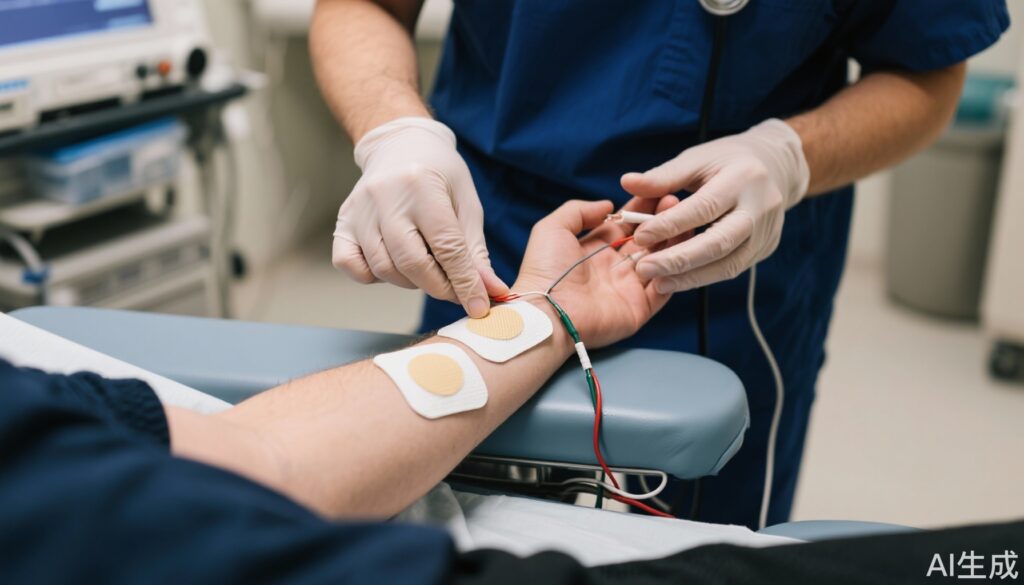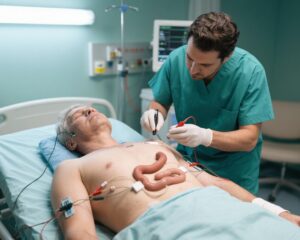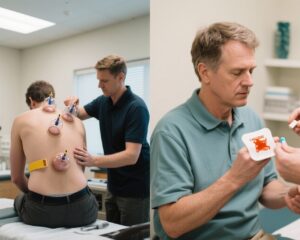Highlight
– Transcutaneous electrical nerve stimulation based on wrist-ankle acupuncture theory (TENS-WAA) significantly lowers pain scores during colonoscopy without anesthesia.
– Male participants showed more pronounced analgesic benefits from TENS-WAA.
– TENS-WAA treatment is associated with stable heart rates during the procedure and increased patient credibility and expectancy scores.
– No adverse effects were observed, indicating a safe noninvasive alternative for procedural analgesia.
Study Background and Disease Burden
Colonoscopy remains the gold standard for diagnosing and monitoring colorectal diseases including cancer, polyps, and inflammatory bowel disease. Despite its clinical indispensability, the procedure is often associated with discomfort and pain, which can lead to reduced patient adherence and procedural avoidance, ultimately impacting early detection and treatment outcomes. While sedation and anesthesia are commonly used to alleviate discomfort, they carry risks such as respiratory depression and increased recovery time. There is a pressing need for safe, effective, and noninvasive analgesic strategies that enhance patient experience during colonoscopy, particularly for those who undergo the procedure without anesthesia.
Wrist-ankle acupuncture (WAA) is a specialized acupuncture method targeting terminal segments of the limbs. When integrated with transcutaneous electrical nerve stimulation (TENS), TENS-WAA may provide analgesic effects through modulation of peripheral and central neural pathways. Prior anecdotal and small-scale studies have suggested the potential of this combined method to relieve various types of pain, but robust, randomized data in procedural contexts like colonoscopy have been lacking until now.
Study Design
This prospective, randomized controlled trial enrolled 120 participants scheduled for colonoscopy without anesthesia. Inclusion criteria encompassed adult patients amenable to non-sedated colonoscopy, excluding those with contraindications to electrical stimulation or WAA.
Participants were randomly assigned to two groups: the trial group received low-frequency, high-intensity TENS-WAA applied at intensity levels adjusted to each individual’s maximum tolerable current; the control group received minimal current stimulation as a sham comparator. The stimulation targeted wrist-ankle acupuncture zones hypothesized to correspond with colonic reflex areas.
The primary endpoint was the retrospective pain score measured by a Visual Analog Scale (VAS), collected immediately post-procedure. Secondary endpoints consisted of procedure duration, heart rate variability during colonoscopy as an objective stress indicator, and the Credibility/Expectancy Questionnaire (CEQ) to evaluate patient perceptions of treatment efficacy.
Key Findings
The analysis revealed that participants in the TENS-WAA group reported significantly lower pain scores (median difference of -1.1 on VAS; 95% CI: -2 to -0.4; P = 0.002) compared to controls. Notably, male participants exhibited greater analgesic benefit (mean VAS difference -1.4; 95% CI: -2.41 to -0.39; P = 0.008), suggesting potential sex-related differences in responsiveness.
Further, the trial group maintained more stable heart rates throughout the colonoscopy, indicating attenuated physiological stress responses (P < 0.001). CEQ scores were also significantly higher in the trial group (P = 0.001), reflecting greater patient acceptance and expectancy of the intervention’s efficacy.
No adverse events related to TENS-WAA were reported, underscoring its safety profile as a noninvasive analgesic modality.
Expert Commentary
These findings introduce TENS-WAA as a promising adjunct or alternative to traditional sedation methods, potentially expanding options for pain management in colonoscopy. The selective enhanced effect in male participants merits further investigation to elucidate underlying biological or psychosocial mechanisms. Possible explanations include differential neural pain modulation pathways or variation in electrical nerve stimulation sensitivity by sex.
While encouraging, the generalizability of results may be limited due to single-center design and exclusion of patients requiring sedation. Additional multicenter trials with larger cohorts and longer follow-up should evaluate TENS-WAA’s impact on procedural tolerance and patient satisfaction comprehensively.
From a mechanistic perspective, transcutaneous stimulation of wrist-ankle acupuncture points likely engages descending inhibitory pain pathways and gate-control mechanisms reducing nociceptive transmission. Integrating traditional acupuncture theories with modern neurostimulation thus holds promise for innovative procedural analgesia.
Conclusion
The randomized trial by Huang et al. provides substantive evidence that TENS based on wrist-ankle acupuncture theory effectively reduces pain during unsedated colonoscopy. It offers a safe, noninvasive, and patient-credible method that particularly benefits male patients. Adoption of TENS-WAA could improve patient comfort, satisfaction, and adherence to colorectal screening protocols.
Future research should aim to optimize stimulation parameters, explore sex-specific response differences further, and assess long-term outcomes related to procedural pain management without the risks inherent to pharmacologic sedation.
References
Huang X, Wang H, Shi L, Xu L, Lv C, Song W, Huang L, Yan F, Shi P, Cai M, Fang F. Effect of transcutaneous electrical nerve stimulation based on wrist-ankle acupuncture theory for pain relief during colonoscopy without anesthesia: a randomized controlled trial. Endoscopy. 2025 Feb;57(2):158-165. doi: 10.1055/a-2373-0513. Epub 2024 Jul 25. PMID: 39053503.



